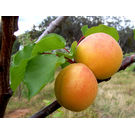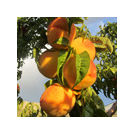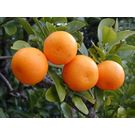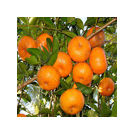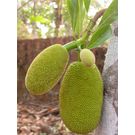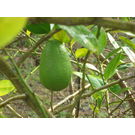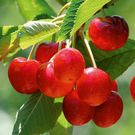Banana / Malbhog Banana Plant

Description
The banana plant, often erroneously referred to as a "tree", is a large herb, with succulent, very juicy stem (properly "pseudostem") which is a cylinder of leaf-petiole sheaths, reaching a height of 20 to 25 ft (6-7.5 m) and arising from a fleshy rhizome or corm. Suckers spring up around the main plant forming a clump or "stool'', the eldest sucker replacing the main plant when it fruits and dies, and this process of succession continues indefinitely. Tender, smooth, oblong or elliptic, fleshy-stalked leaves, numbering 4 or 5 to 15, are arranged spirally. They unfurl, as the plant grows, at the rate of one per week in warm weather, and extend upward and outward, becoming as much as 9 ft (2.75 m) long and 2 ft (60 cm) wide. They may be entirely green, green with maroon splotches, or green on the upperside and red purple beneath. The inflorescence, a transformed growing point, is a terminal spike shooting out from the heart in the tip of the stem. At first, it is a large, long-oval, tapering, purple-clad bud. As it opens, it is seen that the slim, nectar-rich, tubular, toothed, white flowers are clustered in whorled double rows along the floral stalk, each cluster covered by a thick, waxy, hoodlike bract, purple outside, deep-red within. Normally, the bract will lift from the first hand in 3 to 10 days. If the plant is weak, opening may not occur until 10 or 15 days. Female flowers occupy the lower 5 to 15 rows; above them may be some rows of hermaphrodite or neuter flowers; male flowers are borne in the upper rows. In some types the inflorescence remains erect but generally, shortly after opening, it begins to bend downward. In about one day after the opening of the flower clusters, the male flowers and their bracts are shed, leaving most of the upper stalk naked except at the very tip where there usually remains an unopened bud containing the last-formed of the male flowers. However, there are some mutants such as 'Dwarf Cavendish' with persistent male flowers and bracts which wither and remain, filling the space between the fruits and the terminal bud.
As the young fruits develop from the female flowers, they look like slender green fingers. The bracts are soon shed and the fully grown fruits in each cluster become a "hand" of bananas, and the stalk droops with the weight until the bunch is upside down. The number of "hands" varies with the species and variety.
The fruit (technically a "berry") turns from deep-green to yellow or red, or, in some forms, green-and white-striped, and may range from 2 1/2 to 12 in (6.4-30 cm) in length and 3/4 to 2 in (1.9-5 cm) in width, and from oblong, cylindrical and blunt to pronouncedly 3-angled, somewhat curved and hornlike. The flesh, ivory-white to yellow or salmon-yellow, may be firm, astringent, even gummy with latex, when unripe, turning tender and slippery, or soft and mellow or rather dry and mealy or starchy when ripe. The flavor may be mild and sweet or subacid with a distinct apple tone. Wild types may be nearly filled with black, hard, rounded or angled seeds 1/8 to 5/8 in (3-16 mm) wide and have scant flesh. The common cultivated types are generally seedless with just minute vestiges of ovules visible as brown specks in the slightly hollow or faintly pithy center, especially when the fruit is overripe. Occasionally, cross-pollination by wild types will result in a number of seeds in a normally seedless variety such as 'Gros Michel', but never in the Cavendish type.
Climate
The edible bananas are restricted to tropical or neartropical regions, roughly the area between latitudes 30°N and 30°S. Within this band, there are varied climates with different lengths of dry season and different degrees and patterns of precipitation. A suitable banana climate is a mean temperature of 80°F (26.67°C) and mean rainfall of 4 in (10 cm) per month. There should not be more than 3 months of dry season.
Cool weather and prolonged drought retard growth. Banana plants produce only one leaf per month in winter, 4 per month in summer. If low temperatures occur just at flowering time, the bud may not be able to emerge from the stem. If fruits have already formed, maturity may be delayed several months or completely suspended. If only the leaves are destroyed, the fruits will be exposed to sunburn.
Soil
The banana plant will grow and fruit under very poor conditions but will not flourish and be economically productive without deep, well-drained soil—loam, rocky sand, marl, red laterite, volcanic ash, sandy clay, even heavy clay—but not fine sand which holds water. Over head irrigation is said to improve the tilth of heavy clay and has made possible the use of clay soils that would never have been considered for banana culture in the past. Alluvial soils of river valleys are ideal for banana growing. Bananas prefer an acid soil but if the pH is below 5.0 lime should be applied the second year. Low pH makes bananas more susceptible to Panama disease. Where waterlogging is likely, bananas and plantains are grown on raised beds. Low, perennially wet soils require draining and dry soils require irrigation.
Harvesting
Banana bunches are harvested with a curved knife when the fruits are fully developed, that is, 75% mature, the angles are becoming less prominent and the fruits on the upper hands are changing to light green; and the flower remnants (styles) are easily rubbed off the tips. Generally, this stage is reached 75 to 80 days after the opening of the first hand. Cutters must leave attached to the bunch about 6 to 9 in (15-18 cm) of stalk to serve as a handle for carrying. With tall cultivars, the pseudostem must be slashed partway through to cause it to bend and harvesters pull on the leaves to bring the bunch within reach. They must work in pairs to hold and remove the bunch without damaging it. In the early 1960's a "banana bender" was invented in Queensland—an 8-ft pole with a steel rod mounted at the top and shaped with a downward pointing upper hook and an upward-pointing lower hook, the first to pull the pseudostem down after nicking and the second to support the bent pseudostem so that the bunch can be cut at a height of about 4 1/2 ft ( 1.35 m).
Pests
Wherever bananas and plantains are grown, nematodes are a major problem. In Queensland, bananas are attacked by various nematodes that cause rotting of the corms: spiral nematodes—Scutellonema brachyurum, Helicotylenchus multicinctus and H. nannus; banana root-lesion nematode, Pratylenchus coffaea, syn. P. musicola; and the burrowing nematode, Radopholus similis less than 1 mm long, which enters roots and corms, causing red, purple and reddish-black discoloration and providing entry for the fungus Fusarium oxysporum. And also prevalent is the root-knot nematode, Meliodogyne javanica.
Plantains in Puerto Rico are attacked by 22 species of nematodes. The most injurious is the burrowing nematode and it is the cause of the common black headtoppling disease on land where plantains have been cultivated for a long time. Wherever coffee has been grown, Pratylenchus coffaea is the principal nematode, and where plantains have been installed on former sugar cane land, Meliodogyne incognita is dominant. These last two are among the three most troublesome nematodes of Surinam, the third being Helicotylenchus spp., especially H. multicinctus.
You may also be interested in
Look for Similar Items by Category
- Home > Fruit Plants > Banana



